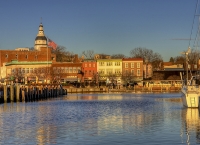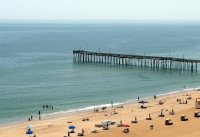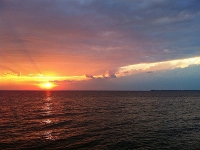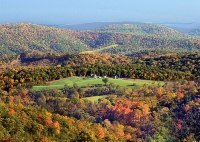Province guides

Attractions
Often referred to as 'America in Miniature', the small state of Maryland is a traveller's playground of varied landscapes, and diversity of cultures and attractions. From the Appalachian Mountains in the west to the long, white-sand beaches in the east, and through its wonderful collection of lively cities and historical sites, Maryland possesses a bit of everything that's great about the US.
History enthusiasts should make a point of exploring the rich heritage of the state capital, Annapolis, and its colonial-era landmarks, which include the Maryland State House and the United States Naval Academy. Or they can spend some time at Antietam National Battlefield, where pivotal moments of the Civil War are brought to life.
For outdoor enthusiasts, a visit to Assateague Island National Seashore is in order to marvel at its untamed beauty and glimpse the famous wild horses roaming the sandy shores. They can also hike along the rugged Appalachian Trail in Western Maryland, and enjoy the scenic vistas on offer. Kayaking in Chesapeake Bay is a must.
Culture lovers will relish the galleries, theaters and boutiques in the charming town of Frederick; foodies should try Maryland blue crab.

Annapolis
Situated only 35 miles (56km) south of Baltimore, Annapolis is not only the small capital of Maryland but also considered the sailing capital of the USA. A huge concentration of re…
Annapolis
Situated only 35 miles (56km) south of Baltimore, Annapolis is not only the small capital of Maryland but also considered the sailing capital of the USA. A huge concentration of recreational and racing yachts shelter in its marina. It's also a college town and has been home to the US Naval Academy since 1845.
The waterfront has grown in to an attractive district, having retained its 18th century appeal despite the collection of boutiques, upmarket shops, bars, restaurants and inns. These cater to the onshore sailing crowd and tourists drawn to the city's history, nautical outlook, and reputation as a party town.
Much of Annapolis's colonial past is preserved in the thousands of historical buildings scattered along the narrow streets and brick-paved sidewalks. The concentration of original colonial-style houses and grand public buildings is greater here than anywhere else in the country. Among the elite brick manors are numerous pastel-coloured rows of wooden slatted cottages that lead down to the waterfront.
At the centre of Annapolis is the Maryland State House that once served as the capitol of the country, where George Washington resigned as Commander-in-Chief and where Congress authorised the treaty ending the Revolutionary War. The city is a good base from which to explore the small towns across Chesapeake Bay on the Eastern Shore, by way of the Chesapeake Bay Bridge. Annapolis is also ideally situated for weekend trips to Washington DC and provides more budget-friendly accommodation for travellers to America's capital.

Ocean City
With more than 10 miles (16km) of white-sandy beaches and pounding surf, Ocean City is Maryland's number one holiday destination, with so many visitors during the peak summer month…
Ocean City
With more than 10 miles (16km) of white-sandy beaches and pounding surf, Ocean City is Maryland's number one holiday destination, with so many visitors during the peak summer months that it becomes the second largest city in the state for the season. The town is dominated by the famous old boardwalk, which is lined with shops, bars and restaurants, flashing neon signs and holiday condos.
Among the ice-cream stands and all-night fast-food franchises are hotels dating back to the 1920s. The fishing pier at the end of the Ocean City boardwalk has an amusement park with a huge Ferris wheel. There are plenty of activities including boating and deep-sea fishing, mini-golf courses, tram rides as well as the beaches.
Those who want to escape the holiday crowds in Ocean City can head to the Assateague Island National Seashore is a 37-mile (60km), which is stretch of wild and undeveloped beach and marshland that extends into Virginia. Little brown and white ponies are the only inhabitants that roam the dunes and graze in the grassy marshes. The main roads and paths can be crowded in summer with people coming to see the legendary wild ponies, but a short way off the main routes will bring the peace one may be looking for.

The Eastern Shore
The Eastern Shore occupies more than half of the Delmarva Peninsula shared between Maryland, Delaware and Virginia, protecting the towns along Chesapeake Bay from the Atlantic Ocea…
The Eastern Shore
The Eastern Shore occupies more than half of the Delmarva Peninsula shared between Maryland, Delaware and Virginia, protecting the towns along Chesapeake Bay from the Atlantic Ocean. Although linked to the mainland by the Chesapeake Bay Bridge, life is much slower and sleepier on this side of the bay. Miles of country lanes and Chesapeake waterways await, while old wooden farmhouses and wheat fields, waterfront towns and fishing craft, lonely wind-rusted marshes and the sound of birds give the peninsula its charming character.
On the Atlantic Coast, the summer-swollen resort of Ocean City, with its lovely beaches, amusement arcades, and busy fast-food stands, is the most visited spot on the East Shore. In contrast, the quaint old towns of Oxford, the colonial college town of Chestertown, and Saint Michaels are waterfront communities that sport old-fashioned family-owned stores and are the essence of life along Chesapeake Bay. Crisfield and Smith Island are classic old-world villages in the south and home to huge numbers of soft-shelled blue crabs that are the delicious speciality of Maryland.
Easton is the unofficial capital of the Eastern Shore and is the largest town; visitors will appreciate its picturesque downtown district of historical colonial buildings. The farmlands invite exploration by bicycle along miles of quiet back roads. Visitors can also explore the inlets and rivers by boat, stopping along the way to sample the fish, oysters and crabs found here throughout the year.
Fort McHenry
The Fort McHenry National Monument is forever associated with the US national anthem, written by poet Francis Scott Key while watching the British attack Baltimore during the War o…
Fort McHenry
The Fort McHenry National Monument is forever associated with the US national anthem, written by poet Francis Scott Key while watching the British attack Baltimore during the War of 1812. After more than 25 hours of constant bombing by British naval forces, the fort stood with the flag flying high. Interestingly, it was the only action the brick fort had seen in more than 100 years of guarding the waters approach to Baltimore. A visit includes a short historical film and a guided tour, with exhibits recalling the siege as well as the fort's Civil War service. On summer weekends there are military ceremonies and drills, as well as a living history program simulating the daily activities during the battle. There's also a daily changing of the flag ceremony, with about 20 people required to fold the enormous Star-Spangled Banner. A short talk about the fort, flag and anthem concludes the ceremony. The monument and its grounds are a national park and visits to the parklands are free. From the fort, there are fine views down the Patapsco River to Inner Harbor and towards Chesapeake Bay.
Website www.nps.gov/fomc
Baltimore Museum of Art
Founded in 1914 with a single painting, the Baltimore Museum of Art sits in the leafy neighbourhood of Charles Village. Today, the BMA is home to an internationally renowned collec…
Baltimore Museum of Art
Founded in 1914 with a single painting, the Baltimore Museum of Art sits in the leafy neighbourhood of Charles Village. Today, the BMA is home to an internationally renowned collection of European and American fine and decorative art pieces. These range from 15th through to 19th-century prints and drawings, works by established and emerging contemporary artists as well as objects from Asia, Africa, and the Pacific Islands. Its 90,000 works include the world's largest holding of pieces by Frenchman, Henri Matisse, who was one of the undisputed masters of 20th century art. Two beautifully landscaped gardens surround a grand museum building, and were designed by famous American architect, John Russell Pope. Yoga classes and jazz concerts often take place upon the lawns in the early evening. Visitors can sample signature Chesapeake Bay cuisine on the lovely outdoor terrace of Gertrude's, the BMA's restaurant.
Website www.artbma.org

Western Maryland
Western Maryland is a haven for outdoor enthusiasts in every season, thanks to its beautiful scenery, thousands of acres of parkland, lakes for swimming, fly-fishing and boating, w…
Western Maryland
Western Maryland is a haven for outdoor enthusiasts in every season, thanks to its beautiful scenery, thousands of acres of parkland, lakes for swimming, fly-fishing and boating, winter skiing, and white-water rafting. Visitors can climb the state's highest mountain, hike part of the famous Appalachian Trail, or cycle and hike along the popular Chesapeake and Ohio Canal, which once served as a towpath for mule-drawn barges between Washington DC and Cumberland. The state's largest freshwater lake, Deep Creek Lake, is the hub of outdoor recreation in Garrett County, and offers a variety of water sports, golf, and skiing. Apart from these fine activities and the fantastic scenery, there are a number of quaint small towns. These include Cumberland, Frostville, and Lavale, which have restaurants, antique shops and bookstores in addition to their charm. The haunting plaques of the Civil War battlefield at Antietam are another popular Western Maryland attraction, and a must-see for Civil War history buffs.


